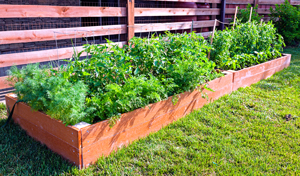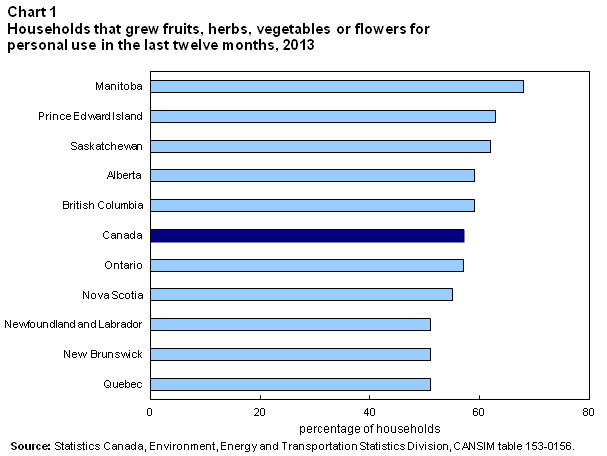Publications
Canadians and Nature: Homegrown fruits, herbs, vegetables and flowers, 2013
Canadians and Nature: Homegrown fruits, herbs, vegetables and flowers, 2013
Archived Content
Information identified as archived is provided for reference, research or recordkeeping purposes. It is not subject to the Government of Canada Web Standards and has not been altered or updated since it was archived. Please "contact us" to request a format other than those available.
by Environment, Energy and Transportation Statistics Division
In 2013, more than half of Canadian households (57%) reported that they grew fruits, herbs, vegetables or flowers for personal use in the last twelve months. Households in Manitoba (68%) were the most likely to have done this. Newfoundland and Labrador, New Brunswick and Quebec households were the least likely (51%) to have grown fruits, herbs, vegetables or flowers.

The most common place to have grown these types of plants was in the yard (81% of these households), however balconies (30%) and indoors (22%) were also frequently reported locations. Four percent of households that grew fruit, herbs, vegetables or flowers for personal use grew them in community gardens, with households in Quebec reporting this more frequently (9%) than households in other provinces. Community gardens were used by 5%E of households in low-rise apartments that reported growing their own fruit, herbs, vegetables or flowers.

Households composed exclusively of people between 45 and 64 years old (57%), senior-only households (52%), and those with children and teens (68%) were more likely to have grown fruit, herbs, vegetables or flowers than households composed solely of people between 20 and 24 years of age (41%E) and 25 and 44 years of age (43%).
Households that owned the dwelling they lived in were almost twice as likely to report growing fruit, herbs, vegetables or flowers as households that rented their homes (65% compared to 34%). While households that owned their dwelling were also almost twice as likely as those who didn't to have grown these plants in the yard (88% compared to 46%, respectively), they were less likely to have grown them on balconies (27% of owners compared to 43% of non-owners) or indoors (20% of owners compared to 32% of non-owners).
Start of text box
About the Households and the Environment Survey
The Households and the Environment Survey asks Canadian households about their activities and behaviours with respect to the environment. It covers a wide variety of topics including water and energy consumption and conservation, hazardous products used in the home, and the household's interactions with nature. Data from the survey are used by governments to guide policies and programs, by researchers to learn more about Canadians and by individuals to see how they compare to the rest of the country.
The target population of the 2013 Households and the Environment Survey consisted of households in Canada, excluding households located in Yukon, Northwest Territories and Nunavut, households located on Indian Reserves or Crown lands, and households consisting entirely of full-time members of the Canadian Armed Forces. Institutions and households in certain remote regions were also excluded.
End of text box
Start of text box
Definitions, data sources and methods: Survey number 3881
Available in CANSIM: tables 153-0156 to 153-0158.
For more information, or to enquire about the concepts, methods or data quality of this release, contact us (toll-free 1-800-263-1136; 514-283-8300; infostats@statcan.gc.ca) or Media Relations (613-951-4636; statcan.mediahotline-ligneinfomedias.statcan@canada.ca).
End of text box
- Date modified:
